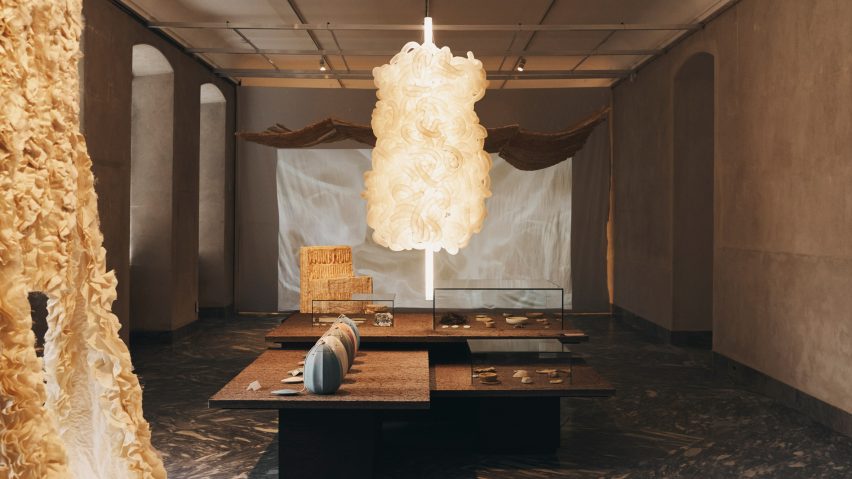Designmuseum Denmark has looked at how design can shape the future through its The Future is Present exhibition, which features projects including a tubular chandelier made from cow intestines.
Presented at Copenhagen's recently renovated Designmuseum, the exhibition showcases a range of "speculative and suggestive" works that examine four themes titled Human, Society, Planet+ and Imagining the Future.
"Design is very much a forward-looking profession," said exhibition curator Pernille Stockmarr. "It's about changing the existing into something better – and what we do in the present creates the future."
"Living in a time with major global challenges, this exhibition wants to invite people to see and reflect on the different potentials of design in this transformation and encourage them to think about what kind of future we want," she told Dezeen.
Among the pieces on show is Inside Out, a chandelier-style lamp made from 100 metres of knotted cow intestines extracted from eight cows. Designer Kathrine Barbro Bendixen aimed to explore how byproducts can be used to rethink patterns of material consumption.
Faroe Islands-based fashion brand Guðrun & Guðrun created Vindur, a ruffled dress with exaggerated bell sleeves made of woven silk and machine-knitted milk yarn sourced from dairy production waste.
The brand worked with textile designers Amalie Ege and Charlotte Christensen and Lifestyle & Design Clusters to create the garment, which was made using a "traditional technique used during the inter-war period when resources were in short supply and waste was transformed into value," according to the Designmuseum.
More conceptual works include Beyond Life, a collection of biodegradable paper foam urns by designer Pia Galschiødt Bentzen with detachable pendants containing seeds that can be grown.
"Beyond Life unites death, loss, and remembrance with the awareness that we humans are part of nature's endless circle of life," said Stockmarr.
Also on show is Library of Change, a "map" of dangling acrylic foil cards charting current trends and technologies, inscribed with questions for visitors such as "would you leave the city for better connection?"
Stockmarr explained that the exhibition aims to communicate "the breadth of design" by including works that vary in scale, purpose and medium.
"Their ability to inspire, start conversations and make visitors reflect was a priority," she said.
"I didn't want the works to be too-defined solutions for the future, extreme sci-fi visions, utopias or dystopias, but exploratory works. Some are collaborative research projects and others provide foresight into design methods, handicrafts and creative experiments."
Alongside the various projects in the exhibition, artefacts from the Designmuseum's own archive that highlight past ideas for the future are also on display.
One of these designs is the three-wheeled vehicle Ellert, Denmark's first electric car developed in the 1980s by engineer Steen Volmer Jensen.
Local studio Spacon & X created the exhibition design for The Future is Present with the aim of reflecting its themes.
The studio delineated the show's various zones using modular bioplastic dividers that snake through the exhibition space and worked with natural materials including eelgrass, which was used to create acoustic mats to manage noise in the museum.
Objects are arranged on custom tables and plinths made in collaboration with sustainable material manufacturer Søuld, while Natural Material Studio created a mycelium daybed for the show.
Stockmarr explained that the show is meant to be a call to action and empower people to reflect on their individual roles in determining the future of design.
"By asking more questions than giving answers the exhibition wants to inspire visitors," reflected the curator.
"The show acknowledges that it is not only designers, architects, craftspeople and experts, but all of us who are participating in shaping and designing the future by the questions we ask and the choices and actions we take today."
Similar recent exhibitions that explored the climate impact of materials include a show at Stockholm Furniture Fair that visualised the carbon emissions of common materials such as concrete and The Waste Age – a London exhibition that addressed how design has contributed to the rise of throwaway culture.
The Future is Present is on display at Designmuseum Denmark from 19 June 2022 to 1 June 2023. See Dezeen Events Guide for an up-to-date list of architecture and design events taking place around the world.

